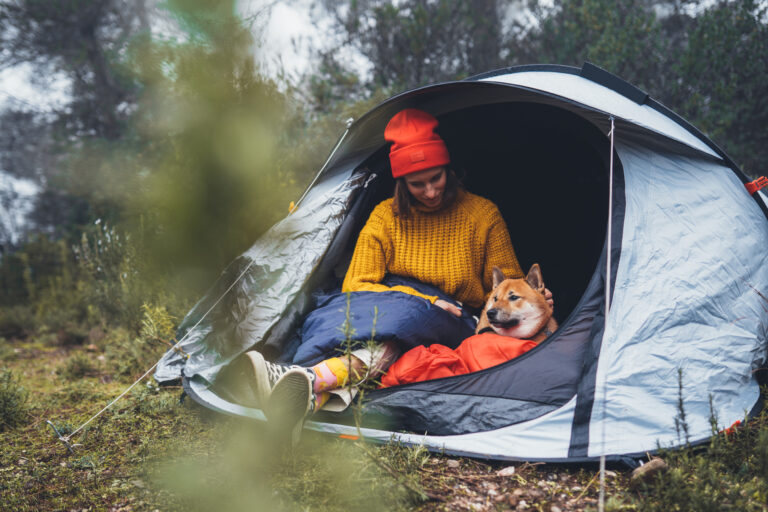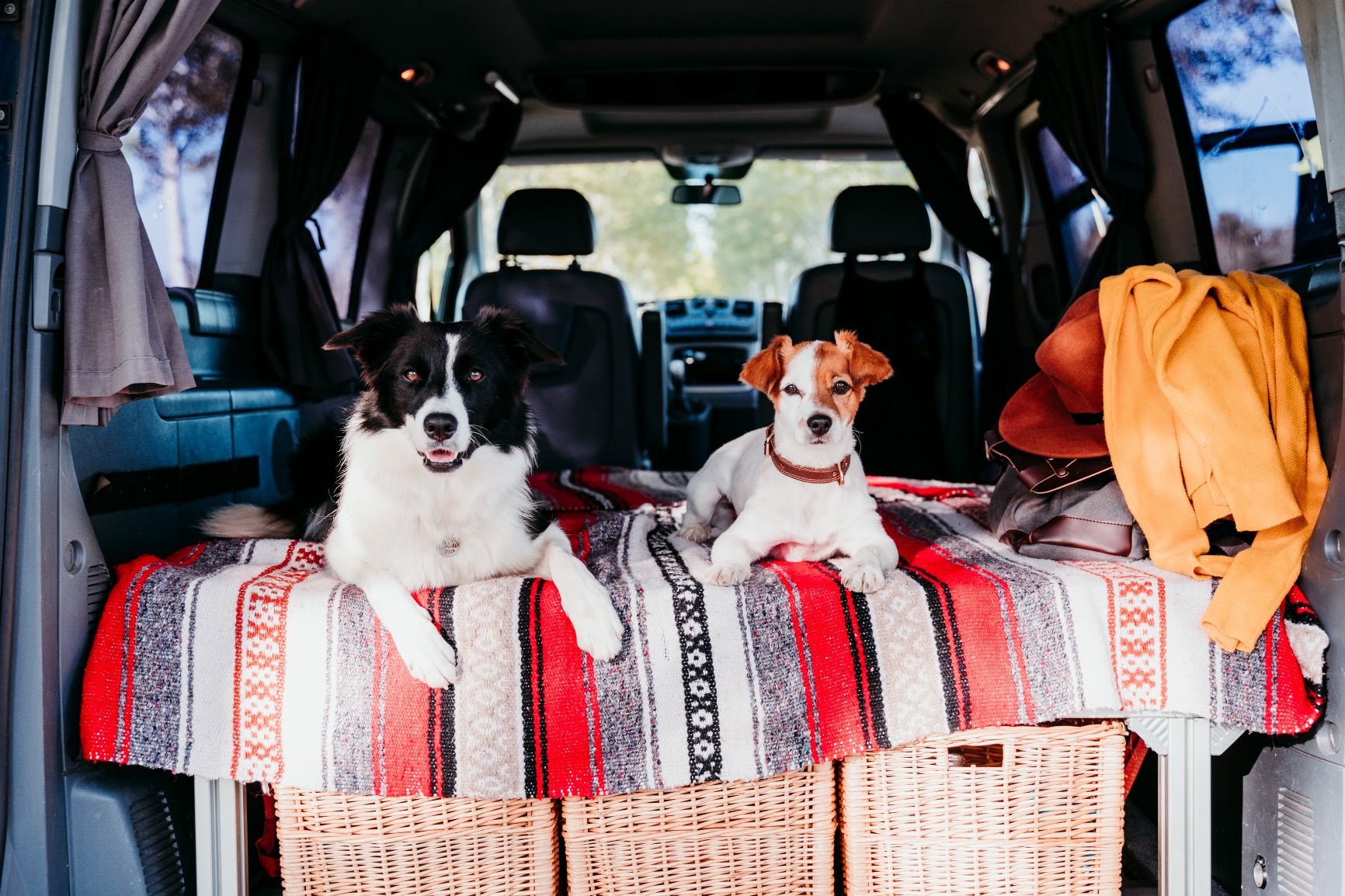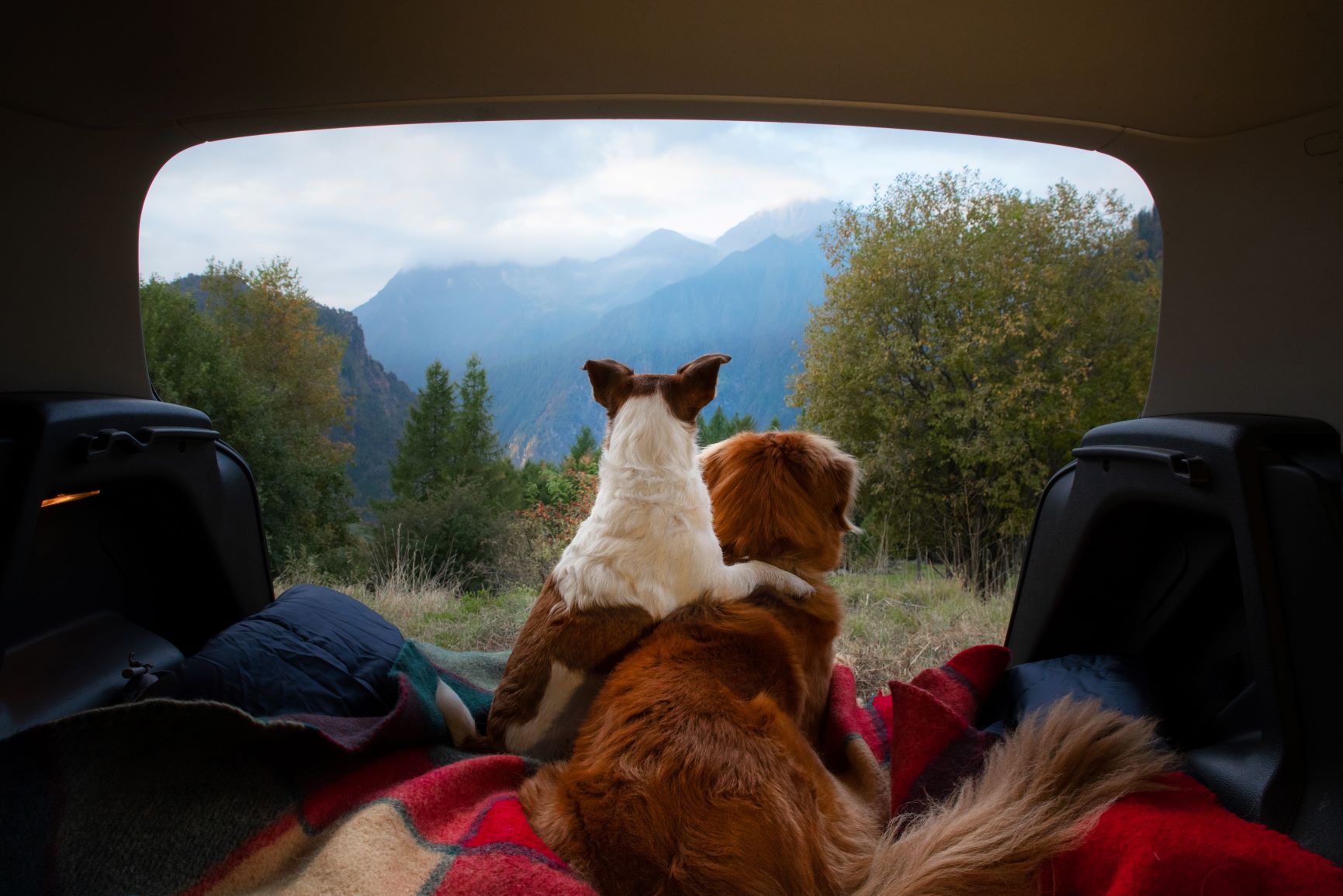Hiking with Dogs – Everyday Adventures
Be it short hikes in the surrounding area, day trips at the weekend or whole hiking holidays with your dog, hiking is a great hobby for human-canine teams!
Be it a caravan, motorhome or tent, camping is certainly more popular than ever with holidaymakers. But is a camping holiday possible with dogs too? How do I find canine-friendly campsites? How do I transport a dog in a caravan and where does it sleep in a tent? Find out everything you need to know about camping with dogs.

tourist traveler hugging relaxation red shiba inu in camp tent on background foggy forest, smile hiker woman with puppy dog in mist nature trip, friendship love concept, girl resting dog together
Many dog owners don’t want to miss out on the opportunity to spend the night in the midst of unspoilt nature, breathe in plenty of fresh air and feel a sense of freedom. With good reason, because for our furry friends too there’s nothing better than spending the whole day outside with us, being able to run to the nearby beach at will and feeling the sand beneath their paws. And owners have to do without hardly anything when camping.
The times in which camping was only something for Boy Scouts and passionate outdoor fanatics are a thing of the past. Well-maintained sanitary facilities, a small supermarket, restaurants, play areas and a pool are now standard features of many European campsites. If you don’t wish to sleep in a tent, you can rent comfortable caravans from home or small mobile homes on site.
To make a camping holiday with dogs a dream holiday for all involved, you should focus on a few points regarding holiday planning, travelling to and staying at the campsite.
Simply packing a tent in your car boot and travelling south hoping for the best isn’t recommended with dogs. For instance, many dogs first have to get accustomed to long car journeys. When you reach your destination completely exhausted from driving and soothing your dog, you then discover that no dogs are allowed at the campsite you are heading for. This happens particularly often during peak holiday season, because dogs are banned on many campsites in the summer months of July and August. Fortunately some campsite operators have recognised the problem for dog owners and now clearly advertise with a ‘heart for dogs’.
First of all, you should be clear about what you expect from a campsite. For instance, there’s a difference between dog-friendly campsites and those where dogs are merely allowed. Campsites where dogs are allowed don’t usually offer anything else for dogs apart from a pitch for the caravan or tent. On the other hand, dog-friendly campsites or those promising a heart for dogs in their brochure or on their website entice dog owners with a range of pet-related offerings. Poo bag stations, dog food in the campsite supermarket, water bowls by sanitary facilities and restaurants, dog showers, a fenced dog meadow or canine play area for letting off steam – campsite operators can come up with a few ideas for four-legged guests. There are even dog schools with their own obstacle course and trainers on some campsites.
Give some thought to what’s important to you on holiday.
Are you just bothered about spending time outdoors in your campervan or tent and can accept certain discomforts on the campsite, such as a lack of dog poo bins or dog showers? In this case, a campsite close to nature where dogs are allowed will certainly suffice.
Or do you want as much comfort as possible when camping with your dog? Are you going to spend a lot of time on site and would like to deal with as little as possible – other than your dog? In this case, a campsite where dogs are expressly welcome with additional services for canines will probably be a better choice.
At the start of planning any holiday, the subject of the destination will clearly come up. Mountains or beach? In the sunny Mediterranean, cool Scandinavia or something closer to home, such as near a dog beach on the coast of the German North or Baltic Sea?
Are you keen on long, flat sandy beaches where your dog can run around freely? Camping sites on the German, Dutch or Danish coast are a suitable option. There are numerous dog-friendly campsites that have direct access to dog beaches and are also connected to a well-developed network of cycling and hiking trails.
In terms of cleanliness, these campsites and natural beaches where you can usually find poo bag stations are streets ahead. However, you shouldn’t just research the campsite in advance, but the nearby beach too. Some North and Baltic Sea beaches are off limits for dogs in the height of summer or they need to be on their lead. Thankfully though there are many dog beaches along the coast where your dog can run around.
 © Eva / stock.adobe.com
© Eva / stock.adobe.com
Would you like to have as much sun as possible on holiday, jump in the warm sea water and get to know other regions? You will find plenty of dog-friendly campsites on both the Adriatic and Mediterranean coast. The campsites in Veneto, Italy are a particular highlight. Here you can find everything that appeals to dogs and their owners: Campsites with their own obstacle courses, exercise areas, play areas and dog trainers, dog sitters or even canine ambulances in case your dog gets sick on holiday. In Croatia, especially in Istria, and the south of France, e.g. the Côte d’Azur or Languedoc-Roussillon region, there are also some campsites with a proposal specially designed for the needs of dog owners.
If you prefer wearing walking boots to a swimming costume on holiday, you should take a look at Austria, South Tyrol, Switzerland or the German Alpine region. They don’t just have stunning mountain peaks, cosy chalets, refreshing lakes and luscious alpine meadows, but numerous dog-friendly campsites. If your dog loves water, accommodation close to a lake where dogs are allowed to swim is recommended. There are dog beaches on Lake Constance, Lake Foreggen in Bavaria or Austrian lakes like Wolfgang, Achen, Saisser or Traun.
After choosing the destination, the search for a suitable campsite for you and your dog generally commences. As mentioned, the interpretation of dog-friendly varies from site to site. Hence, thoroughly read through the description of the campsite online or in the travel guide and look at reviews from other visitors if possible. Of course every dog and dog owner is different and expectations of a perfect holiday can differ greatly in this respect too. The following checklist should help you to find out which campsite is the best choice for you:
If you have found the perfect campsite, there’s the matter of the journey to the destination. Travelling in a caravan or your own car with a trailer is new for some dogs. If your dog has only ever been to the vet and has never had to sit out longer distances in the car or caravan, you should practice this in good time before setting off.
You should consider the method of transportation in the car too. Does your dog feel safe in a carry case or does it prefer to have a clear view out of the window during car journeys?
With the latter option, there are special safety belts with harness that keep your dog and other passengers safe in case of an accident. When choosing a carry case, there are portable cases (for small to medium-sized dogs) as well as fixed boxes.
Make the journey in your car or caravan as varied as possible. The phrase “close your eyes and hope for the best” and covering a distance of 1,000km as quickly as possible isn’t appropriate for camping holidays with dogs.
Instead, the phrase “the journey is the destination” applies! After all, the good thing about camping with dogs is that there are plenty of campsites en route to your destination where you and your dog can stay for a night. Don’t plan more than four to five hours in the car each day and take regular breaks where your dog can get out and move around.
When packing your documents, camera, camping kit and beach equipment, the most important thing is often forgotten: water! Take your dog’s usual water bowl with you in the car and fill it during every break so that your dog can get enough to drink during the journey. During the car journey, chew sticks or objects help your dog to relax.
It can get very hot in the car or caravan. Protect your dog from direct sun exposure, because there is the risk of sunstroke even on long car journeys, e.g. in a traffic jam. A pleasant air temperature, such as from the air conditioning, doesn’t protect your dog from overheating. Cool air in the car cannot offset bright sunlight on your dog’s head.
 © annaav / stock.adobe.com
© annaav / stock.adobe.com
In order for your dog to feel comfortable in the car or mobile home and happy to get back in at any time during the journey, you should end every journey with something positive, such as a nice walk, a long stroking session or a reward in the form of a special treat.
You’ve finally arrived! Experienced campers know what that means: Finding the right parking space on site, pitching the tent if required, setting out the camping chairs and table, extending the awning or hanging up the sun sail.
Before you make a start with this, you should first take care of your dog. Put its lead on and take it for a leisurely walk around the site, explore the exercise facilities and show your four-legged companion where its spot will be for the next few days during the holiday.
To get your dog used to the place, it helps to take a familiar dog blanket or basket from home with you. Space is of course limited in a caravan or mobile home, so possible places for your dog to lie down and for a dog blanket or basket include the space under the table, a driver’s seat or even the bed. Since campsite life takes place predominantly outdoors by the caravan or mobile home, you should set up a nice spot for your dog here too.
Especially during the peak holiday season, there is a lot going on at campsites. Children play catch around tents, neighbours’ dogs bark and tempting food smells rise from the surrounding cooking areas. Some dogs feel stressed by this and therefore need opportunities to retreat. If your dog is very unsettled or barks a lot, it may be necessary to bring it inside the caravan or mobile home. However, a mobile privacy screen helps many dogs by shielding them from hustle and bustle.
Mutual consideration is essential for living alongside one other in harmony not just at home, but when camping with dogs too. After all, both you and the other campers all want to have a nice holiday.
For instance, you shouldn’t just take your dog to the nearest tree when it needs to do its business, but leave the campsite or – if available – go to the designated area. It goes without saying that you should immediately clean up any faeces left by your dog on the pitch.
If you’re staying on a dog-friendly campsite, that still doesn’t mean that the people camping next to you like to have your dog around them as much as you do. Perhaps they don’t like it when your dog constantly goes over to their table and begs for something to eat? Keep your dog under constant control and call it back immediately if it strays too far from your pitch.
Be sure to respect the obligatory lead rule in place at many campsites. You’re best off taking a drag lead with you that you can attach to a tree or with a special ground anchor. Despite the obligatory lead requirement, it allows your dog a good deal of freedom of movement. A metal plate with hooks or eyelets for the lead that you place under the tyre of your mobile home is also a suitable fastening option.
In the midst of so much consideration and adhering to the campsite rules, of course you shouldn’t forget to relax! It’s your holiday and you should primarily use it to switch off and enjoy your time with your dog.
It’s up to you whether you prefer to do so when hiking, sightseeing, sunbathing on the beach or at the campsite. It’s important that you’re at peace and don’t let any of your dog’s little mishaps unsettle you.
A dog isn’t a machine that always works exactly how we may want it to. But the more relaxed you act when camping with dogs, the quicker they will get used to the new environment and the more they will enjoy the trip with you.
Here are some purchase proposals curated by the zooplus editorial team
The products featured have been carefully selected by our editorial staff and are available at the zooplus online pet shop. The selection does not constitute advertising for the mentioned brands.
Be it short hikes in the surrounding area, day trips at the weekend or whole hiking holidays with your dog, hiking is a great hobby for human-canine teams!
Dog lovers like to take their four-legged best friends everywhere with them. As long as it's just ventures within the city, it's self-explanatory that our four-legged family members go everywhere with us. But what's the situation when it comes to holidays? What are the possibilities for animal lovers when moving a long distance? Is there the opportunity to take a dog on a plane? Or is it better for dog owners to tackle long journeys by car?
Be it a caravan, motorhome or tent, camping is certainly more popular than ever with holidaymakers. But is a camping holiday possible with dogs too? How do I find canine-friendly campsites? How do I transport a dog in a caravan and where does it sleep in a tent? Find out everything you need to know about camping with dogs.